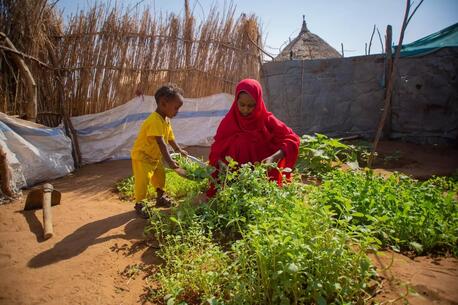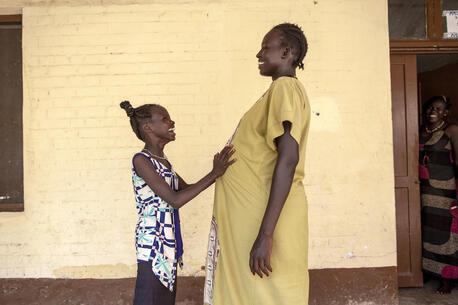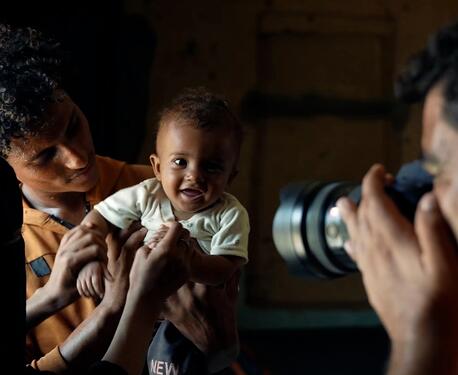Field diary from Kenya: tough love can save lives
In one way or another, every UNICEF staff member around the world is in the business of saving lives. For those who work directly with children and families in health, nutrition and protection programmes, the results are often tangible: a baby immunized against measles, a mother protected from tetanus, one child rehydrated after a dangerous bout of diarrhoea, another rescued from the front lines of armed conflict.
Tim Ledwith is a communications officer for UNICEF. He is currently on assignment in Nairobi, where UNICEF efforts in the Horn of Africa are centralized. He sent us this story about a fellow colleague, whose passion for UNICEF's mandate is an inspiration to us all. In one way or another, every UNICEF staff member around the world is in the business of saving lives. For those who work directly with children and families in health, nutrition and protection programs, the results are often tangible: a baby immunized against measles, a mother protected from tetanus, one child rehydrated after a dangerous bout of diarrhoea, another rescued from the front lines of armed conflict.
It’s a different story for staff members involved in UNICEF’s external communications. We don’t generally see the lifesaving impact of our work first-hand. We can only hope that the messages we convey will strike a chord with donors and lead to greater support for the agency’s worldwide initiatives.
But don’t tell that to Communication Specialist Cifora Monier.
Last week in a remote, semi-arid corner of north-eastern Kenya, Monier was escorting the directors of three UNICEF national committees on a visit to Wajir District Hospital. In a courtyard on the run-down hospital grounds, the delegation met with head nursing officer Hassan Abass, who thanked UNICEF for providing robust stocks of therapeutic milk and other supplies used for the treatment of malnourished children. Despite this aid, however, Abass pointed out that Wajir’s hospital, like the entire district, still suffers from poor access to safe water.
After the briefing, Monier led the group into the hospital’s pediatric stabilization center, where they stopped to talk with mothers who sat on low-slung beds with their weakened children, most of whom were hooked up to IV drips.
One of the mothers, Halima Omar, wore a tan hijab and said she was 20 but looked younger. Dozing at her side was Zeitun, her tiny, year-old daughter.
Hospital nutritionist Lucy Gittonga informed the delegation that the little girl was suffering from both malaria and severe malnutrition. Gittonga added that Omar had agreed to antimalarial medication for her child. But after initially consenting, the young mother now refused to let nurses nourish Zeitun through a feeding tube – even though she was too weak to take fortified milk orally. As a result, Zeitun’s chances of survival were practically nil.
“This is very common,” Gittonga said, noting that certain traditional beliefs and practices in the region often stand in the way of needed medical and nutritional interventions.
At this point, Communication Specialist Monier became visibly upset. Within seconds, she switched gears from neutral observer to a more active role. Through a Somali translator, she directed a series of pointed questions to Omar, channelling the kind of tough love that she might give her own teenage daughter.
“Are you a doctor?” she asked. “Do you know this feeding tube will save your child’s life? Has someone told you to refuse this?”
At first, Omar held firm. “If my daughter dies, it’s God’s will,” she said. But as Monier and others persisted, explaining that the feeding tube would not harm Zeitun, she smiled sheepishly. Then she relented, to a sigh of relief from the small crowd that had gathered in the room.
Almost immediately, a nurse arrived with the clear plastic tube in hand. Omar’s smile soured. Seeing that she was too squeamish to hold the child during the procedure, Monier volunteered to hold her instead. She cradled Zeitun in her lap as the nurse lubricated the tube, inserted it through Zeitun’s nostril and taped it firmly in place. The baby cried for a few moments but calmed down by the time Monier handed her back to her mother.
“You made the right decision,” Monier told Omar, who began smiling again. The next day, Monier returned to the hospital and found the feeding tube intact. Assuming that Omar hasn’t changed her mind since then, Zeitun should be on the way to recovery by now.
Monier’s decision to take action in Wajir may not have been consistent with her job description, but it was completely in line with UNICEF’s mandate: to use every tool at its disposal for the best interests of every child.
That mandate is being tested in north-eastern Kenya and the rest of the Horn of Africa. Here, a perfect storm of prolonged drought, seemingly intractable conflict and soaring food prices threatens not only lives but ways of life that have endured for centuries. Yet even in the midst of such a complex crisis, it’s possible – and necessary – to seize the moment and try, at least, to save one life.
In one way or another, every UNICEF staff member around the world is in the business of saving lives. For those who work directly with children and families in health, nutrition and protection programs, the results are often tangible: a baby immunized against measles, a mother protected from tetanus, one child rehydrated after a dangerous bout of diarrhoea, another rescued from the front lines of armed conflict.
It’s a different story for staff members involved in UNICEF’s external communications. We don’t generally see the lifesaving impact of our work first-hand. We can only hope that the messages we convey will strike a chord with donors and lead to greater support for the agency’s worldwide initiatives.
But don’t tell that to Communication Specialist Cifora Monier.
Last week in a remote, semi-arid corner of north-eastern Kenya, Monier was escorting the directors of three UNICEF national committees on a visit to Wajir District Hospital. In a courtyard on the run-down hospital grounds, the delegation met with head nursing officer Hassan Abass, who thanked UNICEF for providing robust stocks of therapeutic milk and other supplies used for the treatment of malnourished children. Despite this aid, however, Abass pointed out that Wajir’s hospital, like the entire district, still suffers from poor access to safe water.
After the briefing, Monier led the group into the hospital’s pediatric stabilization center, where they stopped to talk with mothers who sat on low-slung beds with their weakened children, most of whom were hooked up to IV drips.
One of the mothers, Halima Omar, wore a tan hijab and said she was 20 but looked younger. Dozing at her side was Zeitun, her tiny, year-old daughter.
Hospital nutritionist Lucy Gittonga informed the delegation that the little girl was suffering from both malaria and severe malnutrition. Gittonga added that Omar had agreed to antimalarial medication for her child. But after initially consenting, the young mother now refused to let nurses nourish Zeitun through a feeding tube – even though she was too weak to take fortified milk orally. As a result, Zeitun’s chances of survival were practically nil.
“This is very common,” Gittonga said, noting that certain traditional beliefs and practices in the region often stand in the way of needed medical and nutritional interventions.
At this point, Communication Specialist Monier became visibly upset. Within seconds, she switched gears from neutral observer to a more active role. Through a Somali translator, she directed a series of pointed questions to Omar, channelling the kind of tough love that she might give her own teenage daughter.
“Are you a doctor?” she asked. “Do you know this feeding tube will save your child’s life? Has someone told you to refuse this?”
At first, Omar held firm. “If my daughter dies, it’s God’s will,” she said. But as Monier and others persisted, explaining that the feeding tube would not harm Zeitun, she smiled sheepishly. Then she relented, to a sigh of relief from the small crowd that had gathered in the room.
Almost immediately, a nurse arrived with the clear plastic tube in hand. Omar’s smile soured. Seeing that she was too squeamish to hold the child during the procedure, Monier volunteered to hold her instead. She cradled Zeitun in her lap as the nurse lubricated the tube, inserted it through Zeitun’s nostril and taped it firmly in place. The baby cried for a few moments but calmed down by the time Monier handed her back to her mother.
“You made the right decision,” Monier told Omar, who began smiling again. The next day, Monier returned to the hospital and found the feeding tube intact. Assuming that Omar hasn’t changed her mind since then, Zeitun should be on the way to recovery by now.
Monier’s decision to take action in Wajir may not have been consistent with her job description, but it was completely in line with UNICEF’s mandate: to use every tool at its disposal for the best interests of every child.
That mandate is being tested in north-eastern Kenya and the rest of the Horn of Africa. Here, a perfect storm of prolonged drought, seemingly intractable conflict and soaring food prices threatens not only lives but ways of life that have endured for centuries. Yet even in the midst of such a complex crisis, it’s possible – and necessary – to seize the moment and try, at least, to save one life.

UNICEF's Cifora Monier holds Zeitun as a nurse prepares to insert a feeding tube in the baby’s nose in the UNICEF-supported stabilization centre at Wajir District Hospital.|© UNICEF Kenya/2011/Gangale


